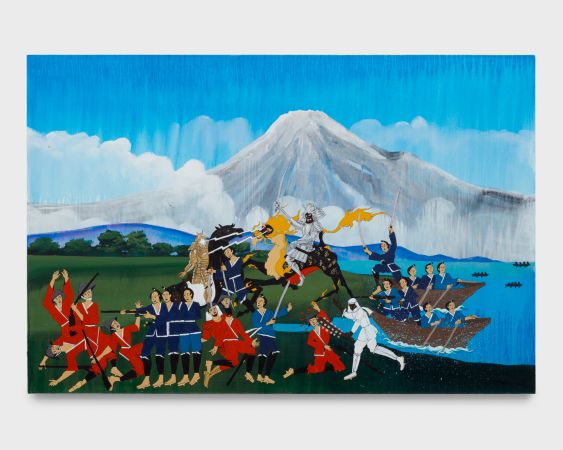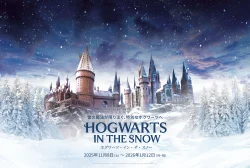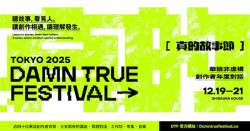
Kagetora’s dream in the time of Sakoku. (Reds and Blues). Part 1
Sep 02, 2023 at 12:00am ~ Oct 14, 2023 at 11:59pm
Blum & Poe is pleased to present: Kagetora’s dream in the time of Sakoku. (Reds and Blues). Part 1
The limits of isolation on the body politic creates the pockets of resistance. The rebellion is always glamorous in the beginning.
The revolutionary ultimately dies, acquiesces, or embraces escapism as a balm. The visionary, however, maneuvers uncertainty with purpose and nurtures the vision beyond the boundaries of mortality. There, it grows. Long live the dreamers of the impossible dreams. In Kirin, we confide.
This presentation marks Los Angeles-based artist Umar Rashid’s second solo exhibition with the gallery and his first in Japan.
Rashid makes paintings, drawings, and sculptures that chronicle the grand historical fiction of the Frenglish Empire (1648–1880) that he has been developing for over seventeen years. Critiquing common renditions of the past, Rashid poses hyperbolic counter-narratives that call attention to and propose reconsiderations of neglected or hidden portions of certain moments in history. This latest installment in the artist’s visual epic picks up where Rashid’s recent solo exhibition at MoMA PS1, Ancien Regime Change 4, 5, and 6, left off, continuing this grand saga into the late eighteenth and early nineteenth century in East Asia.
Many of the paintings in Kagetora’s dream in the time of Sakoku. (Reds and Blues). Part1 take locations within Japan as their backdrop. A meticulous viewer will be able to spot Kanagawa Prefecture, Shizuoka, Niigata (previously Echigo), the island of Dejima, and others. Loosely following the happenings of Japan’s Sakoku isolationist period, this story charts the adventures of the fictitious Order of the Kirin across Japan and beyond. Dissatisfied with Japan’s isolationist policies, this honorable and peace-loving order ironically declares war against the government, battling their way across the aforementioned sites throughout Japan.
Kirin, in this case, alludes to the chimerical creature of Japanese mythology said to bring good omens, as well as to the eponymous Japanese beer company. The contrast between these two references playfully reflects Rashid’s perspective on the fallacy intrinsic to history—binaries around good and evil are often revisionist and oversimplified. The artist’s protagonists are all at once righteous, hostile, and bumbling. The exhibition’s storyline progresses with the central characters having lost their rebellious war. We follow the Kirin’s retreat—tail between their legs as they flee—sailing through the Sea of Japan, the South China Sea, and the Indian Ocean.
The final chapter of this addition to Rashid’s saga takes place in Tanzania, where the Order of the Kirin’s leader intends to procure a giraffe. Much like the meandering nature of life itself, this ending airs on the side of the absurd, described by Rashid as “a hardcore Monty Python.” All of the vignettesinKagetora’sdreaminthetimeofSakoku. (RedsandBlues).Part1includeanelementof the surreal, from dance scenes in the sky to animals that shoot laser beams from their eyes.
Through his research-based practice, Rashid asserts that the canons of history are manipulated mechanisms for maintaining systems of power. Rashid deploys humor to conjure and critique fictional narratives that coexist in different locales across the globe during the Colonial Era. By, for example, inserting comic book characters into well-recorded moments in time, the artist takes an absurdist approach to addressing the shortcomings of our shared annals, revealing the inherent weaknesses and limitations therein. Freeing events of the past from their grand narrative, Rashid encourages viewers to analyze historical accounts anew and create informed meaning.
Umar Rashid (b. 1976, Chicago, IL) lives and works in Los Angeles, CA. He received his BA in cinema and photography from Southern Illinois University, Carbondale, IL. His work was featured at The Huntington and the Hammer Museum as part of the biennial Made in LA 2020: a version. Recent institutional solo exhibitions include Ancien Regime Change 4, 5, and 6, MoMA PS1, Queens, NY (2022); What is the color when black is burned? (The Gold War Part 1), University of Arizona Museum of Art, Tucson, AZ (2018); and The Belhaven Republic (A Delta Blues), University of Memphis Galleries A and B, Memphis, TN (2017). Rashid’s work is represented in the public collections of the Brooklyn Museum, Brooklyn, NY; Hudson River Museum, Yonkers, NY; Jorge Pérez Collection, Miami, FL; Mount Holyoke Art Museum, South Hadley, MA; Nevada Museum of Art, Reno, NV; Ruth and Elmer Wellin Museum of Art at Hamilton College, Clinton, NY; Santa Barbara Museum of Art, Santa Barbara, CA; Wadsworth Atheneum Museum of Art, Hartford, CT; and the Zeitz Museum of Contemporary Art Africa, Cape Town, South Africa, among others.
* Feature image credit: ©Umar Rashid; Courtesy ofthe artist and Blum & Poe, Los Angeles/New York/Tokyo









